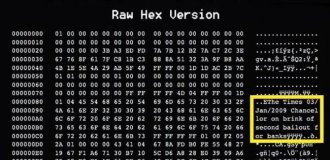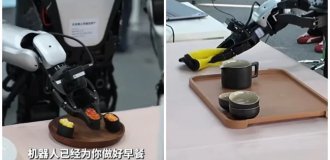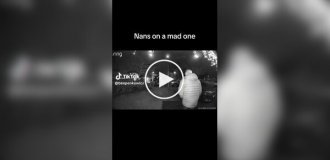Stories of great logos (55 photos)

Wikipedia
In May 2010, Wikipedia unveiled a 3D model of its famous puzzle globe logo. After several attempts to create a real souvenir globe-puzzle, Wikipedia thought about creating a virtual 3D ball, completely covered with the written characters of the alphabets of the world. 3D animator, art director and graphic designer Philip Metschan, who previously worked at Industrial Light, Magic and Pixar, worked on creating a 3D model of the logo.
In addition to making the globe three-dimensional, they changed the Hoefler font to Linux Libertine and abandoned italics. All this is done in order to facilitate the work of volunteers involved in adapting Wikipedia and its logo into 250 languages of the world.
In general, the history of the Wiki globe looks like this:


WWF
The panda on the logo of the main fighters for saving the planet and endangered species did not always look like a round and very harmonious animal. From 1961 to 1986, she was depicted either playfully falling on her front paws, or scooping up food, or simply clumsy. Moreover, at the very beginning, the WWF symbol had eyes.
In 1986, the panda acquired its final form, and the logo was modified only once - in 2000, the World Wildlife Fund used a new font.

Metro Goldwyn Mayer
One of the very first Hollywood film companies, which is experiencing significant financial difficulties these days, has never changed its chosen image once and for all - a lion roaring in a “frame” of film. Only the style of the name changed, as well as the main character himself. Five different lions have roared in the MGM logo over the course of 95 years; the last one has been roaring for 54 years.

HP
Hewlett Packard refined and redesigned its logo 8 times over the 72 years of its existence, but never moved away from where it started. From 1939, with the release of the company's first product, an audio frequency generator, until the late 60s, HP used two logos of equal importance. The first, consisting of simple lines, was easy to apply to the metal housings of various equipment. And the second one looked good in printed materials.
The subsequent search for color and font led to the fact that in 2009 HP cut off the tails of the letters from the 1938 logo and painted the circle in a blue-blue gradient.

General Electric
The company was formed in 1892 after the merger of Thomas Edison's company and the Thomson-Houston Electric Company.
The font in the modern logo is similar to the font of the very first one, despite almost 120 years of GE history. Over time, the abbreviation acquired a circle with a floral ornament, which was only refined and modernized over the years. In the first half of the 20th century, there were also attempts to fit the decoding into the logo - the full name of General Electric. Then decryption was completely abandoned - there is no need for it, almost everyone in the world knows the company. The current logo was made by Wollf Olins. British designers added blue and abandoned volume. At the same time, GE adopted a new slogan that now defines all communications of the energy giant - “Imagination At Work.”

Lego
The cult Danish construction set Lego has always been called that way - the toy was named that way, shortening the phrase “leg godt” - “play well.” The company's first logo appeared in 1936, two years after the start of work. It’s very difficult to call it a logo - rather, it’s just typed text. After 10 years, they tried to play with the shape of the box and the shape of the parts in the logo, and after another 7 years, they began to discern the features of what the logo would ultimately become.

Nestle
The name of the Swiss holding, which produces a cosmic number of food products, does not translate as “nest”. This is simply the surname of the founder Henri Nestlé, so in the first version of the logo there was no trace of a nest. Only later did the company realize that the founder’s surname was more than similar to the English word “nest,” which translates as “nest.” Since then, it has become a symbol of the company and the embodiment of the family philosophy. There is one funny story connected with the appearance of the Nestle nest: the logo used to have one mother and three chicks. There were two chicks there after the company’s marketers conducted research and found that the most common number of children in one family is two. And therefore, if you throw one chick out of the nest, the logo will resonate in the hearts of a much larger number of mothers.

Yamaha
The maker of motorcycles, musical instruments and high-end audio equipment has had plenty of fun with the logo in the more than hundred years since Thorakusu Yamaha designed its first reed organ in 1887. One thing remained unchanged - three crossed tuning forks, forming a three-rayed complex star. Only in the first version, the tuning fork, a symbol of ideal sound, was in one copy. It was held in the beak of a phoenix bird, reflecting the difficulties that Yamaha had to overcome in building its business.

CBS
Despite the abundance of changes made to the graphic image of the telecaster over 60 years, the schematic image of the eye has never left it. And it hasn’t even changed much in appearance - even after more than half a century, this “eye” still looks modern.

BBC
But British television and radio broadcasters do not have a single recognizable “visual”, with the exception of the actual letters BBC, which have never looked the same in the company’s more than half a century history. Now this is minimalist typography, inscribed in three white squares.

Boeing
The logo of aircraft manufacturers Boeing has more than once included everything that in one way or another relates to flight, replacing each other - a swallow, wings, wings again, a globe, wings again, a star and a globe again. As a result, in 1997, Boeing settled on a schematic image of the globe and a schematic image of the wings at the bottom right.

Adobe Systems
In 1982, 40-year-old Xerox programmers John Warnock and Charles Geschke suddenly quit and created a software company. They named it Adobe, after the creek that ran behind Warnock's house. It is clear that John and Charles had to save on everything so as not to go down the drain and not leave their families without a livelihood. That’s why they didn’t order the logo from a design bureau, but asked Warnock’s wife, Marva, to draw it.

Apple Inc.
A little-known fact about a very famous company - in 1976, Apple was founded not only by two Steves (Jobs and Wozniak), but also by one Ronald. Ronald Wayne invested 10% of the initial capital ($800) into the company and came up with the first logo for the company - it was a nameplate with Newton sitting under an apple tree. The sign was surrounded by almost a heraldic ribbon, on which Apple Computer & Co proudly flaunted. I just want to say: like the logo, like the co-founder. Ronald Wayne worked with the Steves for exactly two weeks. After which he took his 800 bucks - he believed that Apple was too risky a venture and did not want to waste capital.
The Apple I computer was selling slowly, Jobs decided that something needed to change, and started with the logo. The striped apple was created by designer Rob Janoff from Regis McKenna Agency. It lasted 23 years before becoming monochrome and high-tech a year after Jobs returned to the company.

Canon
In 1930, in Japan, Goro Yoshida and his half-brother Saburo Uchida created a company with the name, which doesn’t tell us anything, Precision Optical Instruments Laboratory in Japan. Four years later, developments led to the creation of their first camera, which they named Kwanon, after the thousand-armed Buddhist deity of mercy. All thousand hands couldn’t fit on the logo, but they crammed in as many as they could. We added flames and got more of a picture from ancient books than a logo.
To protect its trademark, the company registered a lot of words that sounded similar to Kwanon. One of them - already known to us Canon - eventually replaced the original name. The existing Canon logo is over 50 years old and still looks modern.

Fedex
The first Federal Express logo appeared in 1973, it did not have any of the abbreviations we are used to, and it did not stand out in any way. In 1994, after the official introduction of the abbreviated name, Lyndon Leader came up with a sign that is now immediately recognized by almost the whole world.
At first glance, the logo is very simple and cute, but there is one detail in it - a small arrow pointing to the right, formed by the letters E and x. Many people don’t see it, but those who know about its existence can no longer help but notice it. This arrow is one of the most striking examples of the use of the subconscious in advertising, it symbolizes forward movement and thinking.

12 years ago, final year Stanford University students Larry Page and Sergey Brin came up with a new search engine and called it... not Google. They called it BackRub, indicating its ability to analyze “back links.” But very soon they changed the name of the engine to Google. This is a slightly modified word “googol”, denoting the last number that has at least some meaning - a one followed by a hundred zeros.
The first Google logo was invented by Sergey Brin himself, while learning to work with the free graphics package GIMP. A little later, he added an exclamation point, apparently trying to pass for a division of the then terribly popular Yahoo! The current logo of the search engine is already in its ninth year - the old logo was brought to life by a professor at the Faculty of Arts at the same Stanford University.

In May 2010, Google essentially removed the shadows from the logo, and it began to look much fresher.

IBM
The history of IBM began as a result of an intricate and long-term merger of various companies - ITR, CSC, CTR. Their almost baroque logos are also shown here. In 1924, the reshuffle was finally completed, and the newly opened company was called International Business Machines.
At the end of the 40s, IBM finally switched to its main activity now - computers (before that they were even involved in meat slicing machines). And to commemorate such radical changes, IBM introduced a new logo - extremely simple and clear. Unlike the extravaganza they had before.
The last serious change to the logo happened in 1972 - “to convey speed and dynamism,” the monolithic letters were striped and painted blue.

Kodak
The first Kodak cameras appeared in 1888. The campaign slogan was: “You press the button, we do the rest.” Back in the 1900s, Kodak was one of the first to attempt to integrate the company's name and image into a symbol. In the 1930s, the familiar yellow and red colors appeared in the logo. In the 60s, corners and curves appeared in the logo, which were abandoned 10 years later. During 1971–2006, the logo did not change significantly. And in 2006, the logo was simplified, thereby giving it a more modern look.

MasterCard
In 1966, 17 bankers united to form the Interbank Card Association (ICA), whose symbol was the Latin “i”. In 1969, the bank was renamed Master Charge, and two intersecting circles appeared in the logo. The symbolic “i” was placed in the lower right corner. In 1979, Master Charge was renamed MasterCard, and the letter “i” disappeared from the logo completely. In 1990, horizontal stripes appeared as a symbol of interbank relationships.

In 2006, a subsidiary of MasterCard International changed its name to MasterCard Worldwide and also introduced a new logo.
To the two circles of the logo, a third one was added, slightly shifted from the center to the right. According to company representatives, these geometric shapes reflect the company's unique triune business model - franchising, processing and consulting.
For the payment system, the logo, thank God, was not changed.

Microsoft
In 1975, the year the company was founded, its name was “Micro-soft”. That’s right, with a hyphen, which was later removed, creating a logo with the disco-style typography that was so popular at the time.
After 7 years, disco went out of fashion, including in design, and Microsoft introduced a new logo with a central letter O in the form of a stylized eye. The company's employees nicknamed him Blibbet and loved him so much that when the logo was changed in 1987, one of the employees created a "Save Blibbet" campaign. They didn’t return the eye, but they made small concessions - they started making “Blibbet Burgers” for employees in the cafeteria.
The logo of the 1987 version was actually the same as what we see now. Designer Scott Baker came up with something that witty people immediately nicknamed Pac-Man, since the same middle O is very similar to the character of the same name from an old but beloved computer game.

Motorola
Motorola - who would have thought! — has been around for 80 years. Since the early 1930s, it has been producing telephones for cars, and 50 years later it switched to commercial production of 1.5-kilogram cell phones.
Initially, the company's name, which was nothing more than the word “motor” combined with the then popular suffix “-ola”, was written in a curly handwritten font, and the letter M as we know it now appeared in 1955. Announcing the change in trade mark, the company’s management stated that “two skyward triangular peaks form an arch in the form of an abstract M, symbolizing the progressive leadership vision of the company.”

Mozilla Firefox
In 2002, companies that did not deal with goods or services for children could still have logos like this fairy-tale bird (although they still appear now). Dave Hyatt and Blake Ross created the free Phoenix web browser. Which they immediately renamed to Firebird and immediately renamed to Mozilla Firefox.
In 2003, the guys were almost inundated with letters from John Hicks of Hicksdesign, an interface designer who suffered from terrible branding. After some time, Mozilla invited him to create a new identity and received the famous logo, which they say can be seen even from space.

Nike
The Nike Swoosh, which is perhaps the most recognizable sign in the world, was invented by Portland University student Caroline Davidson in 1971. She was paid 35 dollars for it, even taking into account the prices of those years, this is pennies. The logo design has hardly changed in 37 years - only the spelling of the brand name has changed, and now it has completely disappeared.

Nokia
In 1865, Knut Fredrik Idestam founded a paper and pulp mill in southwestern Finland. Agree, a very strange start for a company now famous for mobile phones. The company began to bear the name Nokia after it moved to the bank of the Nokianvirta River in the city, actually, Nokia. By the way, the word “Nokia” itself in Finnish means a dark, very furry animal, something like an ermine.

Pepsi
In 1893, a few years after pharmacist Pemberton invented the coca leaf drink, another young North Carolina pharmacist, Caleb Bradham, experimented with different ingredients (particularly pepsin) and came up with Brad's drink, which was in great demand in his pharmacy. .
After 5 years, Caleb had to buy the name Pepsi-Cola for $100, which his failed competitor had already registered. At the same time, Bradham's neighbor came up with the first logo for Pepsi.
Since then, the logo has changed more than once, and now we see a cute three-dimensional striped ball every day. By the way, Coca-Cola, unlike its main competitor, never radically changed the logo, but only “restylized” the very first spelling.

Coca Cola
Pepsi's main competitor all the years of their war calmly watched the throwing of red and blue, occasionally carrying out unnoticeable restyling of their centennial logo. There is only one “shameful moment” in the history of Coca Cola when they literally tried to introduce a new spelling for several months in 1980, but very quickly abandoned this idea. In 2008, Coca Cola again chose a light straightening over a radical restructuring - the company simply removed the “reversal”, and the letters became red and the background disappeared.

Shell
The Shell company appeared in 1891 and was engaged in the maritime transportation of kerosene. The company's first logo was an accurate black and white reproduction of a scallop shell. Over the years, the logo has gradually changed according to new trends in graphic design. The modern logo was created by famous designer Raymond Loewy in 1971. Today it is so recognizable that it is often used without specifying the company name.

Sony
There was only one interesting moment in the history of the Sony logo - the very first logo, which now looks very cute and funny. Already in 1960, the first step was taken towards the logo that the company has now. The modern version was developed in 1973, and the company's management does not intend to change it yet, despite the fact that they regularly receive proposals for restyling or a radical change. And they can be understood - the laconic, very simple word Sony in this spelling is known by the whole world and has no complaints about it.

Starbucks
The evolution of the Starbucks logo is perhaps the funniest of all the ones presented here. Look at the very first mermaid siren inside the circle. A Rubensian beauty without a navel, with two tails and ample breasts is an excellent, very funny image. Even funnier is the company's explanation: "This siren was supposed to be as seductive as Starbucks coffee."
When Starbucks merged with Il Giornale in 1987, the logo became more chaste and more graphic. The “shame” was covered with lush hair, a navel was attached to the right place and a general “zoom” was made on the siren, so as not to attract the audience’s attention so much to thoughts about why the siren needs two tails and whether there is anything interesting between them. In 1992, the consumer was already moved closer to the mermaid, and the long-suffering navel was no longer visible.
Immediately after the new year 2011, Starbucks announced the restyling of its famous mermaid. The green ring with the brand name disappeared from the round logo, and the black and white image of the siren became green and white and took up the entire circle.

Yadrila
Registration: 10/26/08
Posts: 361 Xerox
In 1938, Chester Carlson invented a photocopying technology he called electrophotography. True, then I changed my mind and called it xerography. Like many inventors, he had a very hard time - not a single large company to which he came with proposals accepted him or appreciated his innovations. He went to the small company Haloid, where they helped him make the first photocopier - Haloid Xerox 914. The copier turned out to be so successful that the company gave up on its name and in 1961 adopted the name of the invention - Xerox.
Their very first logo is considered by many to be the best - it lasted 43 years. Then it lost its protrusions and became red, and this year the company made another attempt at rebranding, deciding to position itself only from copiers. The attempt can hardly be called successful - they still think about photocopiers, they still call all the copiers after the company, but on top of all this was added bewilderment from the child’s ball on the right.

Cars
Toyota
Luck—and an easy-to-pronounce name—played a big role in the creation of the Toyota brand in 1936. The book “Toyota: A History of the First 50 Years” tells how company founder Kiichiro Toyoda “launched a competition for the best proposal for a new Toyoda logo. There were over 20,000 entries. The winning entry consisted of katakana letters in a design that conveyed a sense of speed... “Toyoda” became “Toyota” because it was aesthetically pleasing from a design perspective, and because the number of strokes required to write , was equal to eight. And 8 is a lucky number, foretelling ever-increasing prosperity.” The font has not changed since then.


Cadillac
The Cadillac coat of arms is the coat of arms of the French military commander and explorer, Antoine de la Mothe Cadillac, who founded the city of Detroit in 1701. Over the years it has been simplified and given a more up-tempo look, but the basic style remains the same. “It's so special that you'll never want to change it,” says Anne Marie Webb, design manager for GM's Global Brand Identity.


Skoda
Skoda began with the Slavia company, which made bicycles and motorcycles from 1895 to 1905. The logo was a wheel with linden leaves, which were intended to symbolize the Slavic peoples. Later, the names of the company’s founders (Laurin & Klement) were added to the logo, which subsequently became the main motif of the new logo, which lasted right up to 1926.
The logo with the famous winged arrow appeared then for the first time, and its origin is still shrouded in mystery. Sometimes the author of the idea for the image - a schematic drawing of an Indian head in a traditional headdress with five feathers - is considered to be the commercial director of the Skoda Plzen company at that time, T. Maglich. The first version of the logo was left untouched for 70 years, but the second version lasted much less - only 20.
In February this year, Skoda officially unveiled its new logo.
After restyling, the Skoda logo became simpler: the brand name moved from the inside of the logo circle to the outside, and the inside of the emblem became larger. In addition, the inscription “auto” has disappeared from the logo - and so everything is clear to everyone. On cars, the emblem will be used in a monochrome version - without green.

New logo

Ford
The Ford car logo, despite the fact that car plant logos rarely undergo significant changes, was not always the same as we know it.
At the very beginning of the history of the famous car, the logo was black and white, very pretentious and full of gadgets. It was developed by an assistant engineer at the factory. This logo still exists today, but as a story. It is almost never used, but it has changed a little - the frills have been removed.
The blue oval appeared in 1928, since 1976 it began to be attached to all cars without exception coming off the Ford assembly line, and the blue oval received a more modern look for the 100th anniversary of Ford Motors in 2003.

FIAT
The company was founded in 1899. Fiat is an abbreviation for Fabbrica Italiana Automobili Torino (Turin Italian Automobile Plant). In addition, this abbreviation can be translated from Latin as an independent word, often used in church use - “let it be.” The company logo is extremely simple; all its changes can be attributed to changes in design. It either became round or took on a shield shape; the modern logo combines both of these shapes. Interestingly, for most of its history, the logo was a combination of metallic (white) and blue. It seems that shades of blue are the most common color in the auto industry, think BMW, Ford, and Volkswagen. It is said that the creator of the original font and design was inspired by a neon factory sign seen at night.

Volkswagen
The first “people's car” was created in Germany on behalf of Hitler in 1938. The Volkswagen logo was designed by Porsche employee Franz Xavier Reimspiess and chosen after an open competition. The letters “W” and “V”, combined into a monogram, marked the plant’s products throughout its history. After the plant came into British possession, the logo was inverted, and later the background became blue instead of black.

Audi
In 1910, the four companies Audi, DKW, Horch and Wanderer merged into one concern Audiwerke GmbH. The logo of the association was four rings connected in a chain, each of which contained the logo of one of the companies. However, this logo turned out to be too busy, and as a result, only four rings remained. It is interesting that in the modern logo, the four rings seem to be melted from one piece, rather than connected in a chain. Audi translates from Latin as “listen!”

In August 2009, the famous four-ring logo underwent a slight restyling. Both the logo font and the traditional metal rings have been changed: the new logo has become more voluminous, chrome-plated and more photographic.

BMW
BMW stands for Bayerische Motoren Werke (Bavarian Motor Works). From 1913 until the end of the First World War, the plant produced aircraft. After the end of the war in Germany, this was prohibited, and the company was forced to retrain itself into motorized bicycles, motorcycles and cars. But the BMW logo has remained unchanged for almost a century. In the 70-80s, the logo was slightly changed - the rim was painted in different colors. Now the rim was more like a bearing with three chambers, half of each chamber white, half dark blue, light blue or pale red.
The logo myth, created by smart German marketers, has fooled several generations by associating the blue and white circle with aviation. “A German advertising agency in the 1920s created an ad that showed a BMW circle in front of a spinning airplane propeller, reflecting the company's origins as an aircraft engine manufacturer. And then it became a myth,” said Dave Buchko, a spokesman for BMW North America. And while BMW did make aircraft engines, the blue and white logo represents the colors of the Bavarian flag, rather than the propeller and sky.

SAAB
Like BMW, Saab originally made airplanes and stopped doing so after World War II. In 1937, the company was called Svenska Aeroplan Aktiebolaget (“Swedish Airplane Company”) - hence the acronym known throughout the world.
The company's logo is based on the mythical animal, the griffin, with the body of a lion and the head and wings of an eagle, and this animal was in the logo of Vabis-Scania, the truck manufacturer that merged with Saab. The griffin is the heraldic symbol of the province of Scania and has been featured on the Scania logo for 111 years.

Mazda
Mazda's history begins in 1920, when it was called the Tokyo Cork Factory, and produced cork for the needs of the First World War. In 1927 it began producing cars, and after World War II the company became known as Mazda. In 1936, a logo was developed in the form of the letter "M" made up of wavy lines, this emblem was based on the Hiroshima logo. In 1962, the logo was changed; it was still based on the Latin letter “M”, but now in a vertical rather than horizontal composition. In 1991, an emblem was developed, which is now present in a greatly modified form. According to the creators, this emblem means wings, the sun and a circle of light. The modern Mazda logo is called the “owl”, in which the stylized “M” looks like stretched wings - or like the head of an owl -, but some people call this emblem a “tulip”, as it looks like a flower bud. Mercedes-Benz An asterisk with three rays appeared on the logo from a postcard drawn by Daimler Gottlieb, one of the founders of the company. The three rays denoted the three elements - earth, air and water - for which cars were planned to be produced. The three-pointed star was later enclosed in a round rim with the inscription "Benz". Since its development, the logo has not undergone significant changes, with the exception of some color variations. Peugeot The Peugeot concern began in 1812. For several decades, the concern produced steel products, then bicycles; the first car rolled off the assembly line in 1889. The Peugeot logo comes from a heraldic symbol and was designed for Peugeot by jeweler and engraver Justin Blaser, based on the flag of the province in which the Peugeot factory was originally located. At different times, the lion was depicted either in full or only with the head. In 1927, the lion turned to the right, which meant a break with the norms of heraldry, and took on the features of a drawing of a living lion, rather than a heraldic symbol - but later the logo returned to the coat of arms style. In 1950, the lion acquired clearly aggressive features - it reared up, its mouth opened. The logo remains in this form to this day. It is interesting that the color scheme of Peugeot turned out to be unoriginal; it is white and blue, as is the case with Volkswagen, BMW, Ford, and Fiat. This really seems to be the most popular color combination for car logos. And not so long ago, French automakers deprived their lion of his tongue. The designers simplified its design, gave the emblem dynamism and a sense of movement, and combined two material textures in the symbol: matte and shiny. The updated lion, which is the new logo of the Peugeot brand, has become three-dimensional. Renault The first logo used on the company's products consisted of the initials of the three Renault brothers: Louis, Ferdinand and Marcel. During World War I, Renault produced light tanks for the Allied army. In 1925, a diamond-shaped logo appeared, which was modified in 1927 and in this form, with minor changes, has been preserved to this day. Separately, it is worth noting the color scheme: Renault’s color is yellow, a rather rare color for a car brand. Mitsubishi The Mitsubishi logo is the result of a fusion of the family crest of the Iwasaki family (three diamonds) and the Tosa clan (three oak leaves growing from a single point). Yataro Iwasaki came from a family that sold its nobility, and after the Meiji Restoration he was given the Tosa clan's shipbuilding business. Two generations later, Kayota Iwasaki repurposed the business and created the Mitsubishi Motors automobile company. The name in translation means “three diamonds”, or “three diamonds”, the word “hishi” (when combined, the first syllable is voiced according to the rules of Japanese phonetics and “hi” turns into “bi”) means “chestnut”. It is used to denote a diamond shape. Since its creation, the Logo has remained virtually unchanged. Added at 22:46 cool! Thanks It seems that not everything is going smoothly for IBM; there is some kind of trend: To attract the Internet community to the problem of preserving the environment, the logo will be redesigned





















